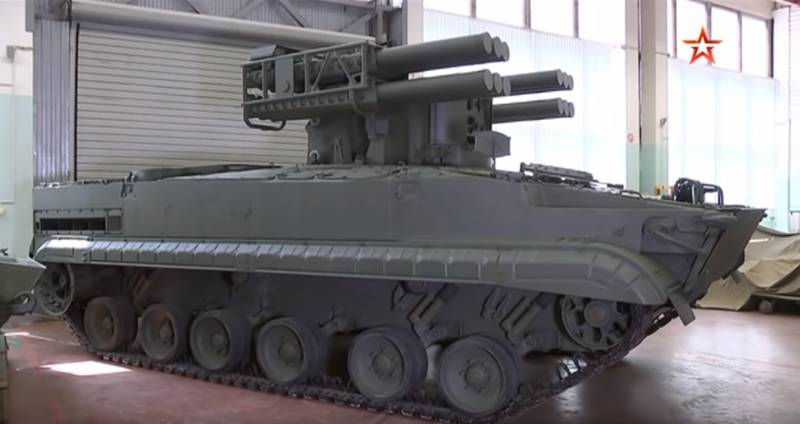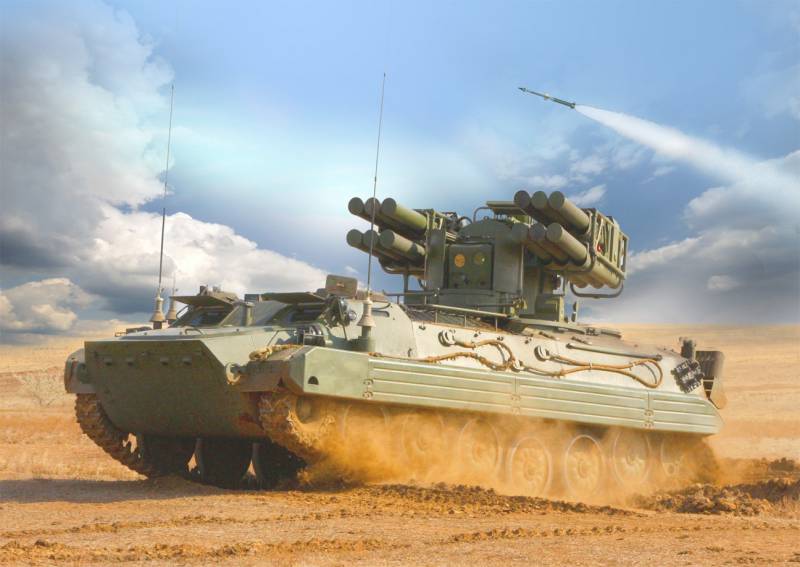SIRS "Pine": obvious advantages and noticeable disadvantages
Serial appearance
Serial samples of "Pines" in their appearance will correspond to the recently shown prototype. The air defense missile system is proposed to be built on the chassis of an infantry fighting vehicle BMP-3 and equipped with a new launcher with the target equipment. On this module, made in the form of a turning tower, two packages are installed with six missiles each.
The launcher is made on the basis of a gyro-stabilized platform. It has an optical and thermal imaging camera, a laser rangefinder with a rocket control function, a system of state recognition and control equipment. Search and maintenance of targets are carried out by optical-electronic means. Rocket guidance is performed using a laser beam guided by automatics. ZRK equipment can operate in fully automatic or semi-automatic modes.
The destruction of targets is carried out using the 9М340 Sosna-R anti-aircraft missile. This 30 kg product is made according to a bicalyber scheme and can reach speeds of up to 900 m / s, as well as maneuver with overloads up to 40. Destruction of targets at distances up to 10 km and altitudes up to 5 km. Used two combat units - armor-piercing and fragmentation. Guidance of missiles is provided by automatic ground-based air defense systems with control using a laser beam.
The Pine air defense missile system is operated by a crew of two people - a driver and an operator. The complex can interact with third-party air defense systems, receiving or transmitting data on the air situation. The task of "Pines" is to escort troops on the march or in positions with simultaneous cover from an air attack. In this role, the new air defense system will replace outdated systems of the Strela family.
Obvious advantages
The serial appearance provides the Strela air defense system with a number of characteristic advantages. One of the main ones is the possibility of mounting the launcher on different chassis with a lifting capacity of at least 4 t. This capability has already been demonstrated using prototypes made on the MT-LB and BMP-3 chassis. The last option received approval and will soon go into the series.
According to some information, in the near future, the Pine will become the basis for the Ptitselov air defense missile system, intended for the airborne troops. In this case, the unified launcher will be mounted on the BMD-4M chassis. Regardless of the specific type of base chassis, the result of the design becomes a combat vehicle that most fully meets the requirements of a specific kind of troops.
All proposed for use of the chassis are in service with different types of troops, which simplifies the introduction and operation of new air defense systems. There is no need to establish the supply of new components. In addition, ready-made complexes can move and work in the same combat formations with other armored vehicles of the army. The unified chassis provides both the required mobility characteristics and a comparable level of crew and equipment protection.
The Pine air defense missile system uses a passive method for detecting and tracking targets. The radiation source is only a laser rangefinder, also controlling the rocket. Such principles of work provide the required efficiency, and also allow solving combat missions at any time of the day and in different weather conditions. At the same time, the probability of detecting air defense missile systems by means of electronic reconnaissance is reduced, and its complete suppression by electronic warfare systems becomes impossible.
The Pine is capable of shooting from a standstill, from a short stop and in motion. In all cases, automation steadily accompanies the selected target and provides guidance of the rocket. Effective control devices allow you to attack both air and ground targets, provided the line of sight. Depending on the type of target, automatic tracking begins at distances up to 25-30 km (airplane type target).
The rocket "Sosna-R" provides a high probability of hitting various targets within the zone of responsibility of the system. High flight speed and the ability to maneuver with overloads allow you to fight a wide range of aircraft and weapons. The used laser beam guidance system virtually eliminates the suppression of the control channel, which increases the probability of hitting the target.
With relatively high performance, the SOSNA-P SAM is characterized by small dimensions and weight. The transport and launch container weighing 42 kg does not require special means of loading. As a result, they did not include a transport-loading machine in the anti-aircraft complex. Ammunition can be delivered by any suitable transport, and its loading onto the launcher by the ZRK crew takes no more than 10-12 min.
From the point of view of certain features and features, the newest “Pine” air defense missile system resembles its predecessors from the Strela family. At the same time, similar ideas are implemented using modern components and technologies. All this leads to an obvious increase in tactical, technical and operational characteristics.
Noticeable flaws
Naturally, the newest complex is not without ambiguous features or obvious flaws. Such features of "Pines" can adversely affect the performance of the equipment or crew and, as a result, affect the practical results.
It is easy to see that the use of the BMP-3 chassis leads to a significant increase in the combat weight of the entire SAM system. The resulting machine should weigh about 18-20 tons, which in a known manner complicates the transfer of military transport aviation and imposes some other restrictions. The Pine variant on the MT-LB chassis is several tons lighter, but loses in the level of protection and some technical characteristics. For all this, the BMP-3 and MT-LB chassis cannot be used for parachute landing, which is why the Airborne Forces needed their own Ptitselov air defense system on the unified BMD-4M chassis.
Means of search and targeting of the Sosna air defense missile system are built on optical-electronic systems. This means that the detection, tracking and destruction of the target are possible only under the condition of direct optical visibility and depend on current conditions. Fog, precipitation and other meteorological phenomena can affect the operation of optics in real combat conditions. In addition, the optoelectronic station has a limited field of view, and the features of its installation on the launcher make it difficult to circular view.
The Sosna-R missile defense system has limited range and altitude characteristics, which is why, in order to ensure a full-fledged air defense system, the Sosna complex must work together with other systems with a larger affected area. In addition, the reduction in mass and dimensions of the rocket affected the weight of the missile warheads, and this may limit its combat effectiveness.
The absence of a TZM complex can be considered an ambiguous feature. On the one hand, it simplifies the rearmament and organization of combat work. On the other hand, the reloading of the launcher rests with the driver and the operator, who after such physical work should return to their direct duties. It cannot be excluded that carrying an 12 TPK with a total weight of about 500 kg can tire the crew and make it difficult to further combat work.
The “Pine” air defense missile system has significant advantages over the Strela family systems, however, in some characteristics it is not very large. For example, the mobility of two complexes is comparable. SAM Pine carries 7-kg warhead against 5-kg in the latest modifications of the Arrows, etc.
Weighted score
It is obvious that the Pine air defense missile system - like any other military equipment - has both strengths and weaknesses. In addition, as his work may reveal various shortcomings and flaws. It is for this purpose that multi-stage tests are carried out, the results of which decide on the future of the new development.
At the end of March this year, the leadership of CB Tochmash, which developed the Pine, announced the successful completion of state trials. By the time such News measures were launched to prepare for the adoption of air defense systems for the arsenal of Russian ground forces. Prototypes confirmed the specified characteristics and were highly appreciated, as a result of which the Sosna air defense system was recommended for operation and mass production.
This fact best of all shows the real balance of advantages and disadvantages of “Pines”. It turns out that the promising air defense missile system has fulfilled all the requirements of the customer, and his appearance corresponds to the desired one. In the presented form, "Pine" will go into service, which will happen in the near future. In addition, in the coming days, the public will be able to see this complex for the first time in serial configuration at the upcoming Army-2019 exhibition.
- Ryabov Kirill
- TRC "Star", KB Tochmash / kbtochmash.ru


Information